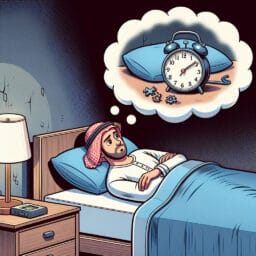
Understanding Sleep Restriction Therapy: Definition and Benefits
Table of Contents
- Introduction
- Definition of Sleep Restriction Therapy
- The Process of Sleep Restriction Therapy
- Benefits of Sleep Restriction Therapy
- Risks and Considerations
- Conclusion
- Frequently Asked Questions
Introduction
Seeking a fresh approach to combating chronic insomnia? Sleep restriction therapy (SRT) might just be the highly effective treatment you’ve been searching for. This behavioral treatment aims at improving sleep efficiency by initially limiting the total sleep time according to a patient’s average total sleep time noted in their sleep diary. Essentially, it is about creating an optimal balance between bed and wake times to enhance the quality of your slumber. SRT can also help in recalibrating circadian timing and increasing sleep pressure, making it easier for individuals struggling with insomnia to fall asleep and stay asleep during the night.
As we all are aware, maintaining a consistent sleep schedule is crucial for our overall health. Disturbed or inadequate rest can lead to various ailments including depression, obesity and heart disease among others. It’s estimated that millions suffer from sleep disorders worldwide highlighting the urgency for exploring effective treatment options like SRT.
While this therapy does require guidance from a trained professional such as a sleep specialist, it has shown promising results especially when combined with other aspects of cognitive-behavioral therapy for insomnia (CBT-I). Furthermore, while acute effects may include daytime sleepiness due to shortened initial ‘sleep window’, these tend to dissipate over time as one’s sleeping pattern gets regulated resulting in restorative and quality shut-eye!
Definition of Sleep Restriction Therapy
A unique observation on Sleep Restriction Therapy (SRT) reveals a revolutionary approach to battling chronic insomnia. SRT, a distinctive behavioral treatment, capitalizes on understanding the importance of sleep pressure and circicadian timing. It’s fascinating how this therapy utilizes an individual’s average total sleep time taken from their sleep diary to customize a precise sleep schedule. This therapy primarily aims at enhancing sleep efficiency by initially curbing the span of sleep time.
At its core, this method focuses on maintaining accurate wake-up times and bedtimes—a critical factor in maintaining your natural circadian rhythm. As daytime progresses, our bodies accumulate ‘sleep pressure’, making us feel drowsy as night approaches. SRT uses this physiological fact to its advantage; by limiting ‘sleep window’, it increases the desire or ‘pressure’ for quality sleep—this results in insomnia patients finding it easier to fall asleep and stay asleep throughout the night.
Comparatively speaking, while other treatments may provide temporary respite from insomnia symptoms, they often do not address underlying issues like irregular sleep schedules or poor sleep hygiene habits that perpetuate disturbed rest patterns. On the contrary, SRT provides an effective treatment by reshaping these ill-formed routines into healthy ones.
However intriguingly counterintuitive it may sound—lessening one’s time allowed for sleeping has shown clinical effects in improving overall quality of rest in chronic insomniacs—and even those with difficulty falling asleep due to shift work disorder! Working under guidance from a trained specialist in sleep medicine can help manage acute effects such as initial daytime drowsiness which commonly occurs when adjusting to new wake times but gradually dissipates as your body adapts towards better improved sleeping efficiency.
| Term | Explanation |
|---|---|
| Sleep Restriction Therapy (SRT) | A behavioral treatment for chronic insomnia that involves limiting time spent in bed to increase sleep pressure and improve sleep efficiency. |
| Sleep Pressure | A physiological concept where the body accumulates a desire for sleep as the day progresses, causing drowsiness by night. |
| Sleep Window | The amount of time designated for sleeping within the SRT approach. It is strategically limited to increase sleep pressure and improve sleep quality. |
| Sleep Efficiency | A measure of sleep quality that compares the amount of actual sleep time with the total time spent in bed. |
| Circadian Rhythm | The body’s internal clock that regulates physiological processes, including the sleep-wake cycle. SRT works by helping to align sleep times with the body’s natural circadian rhythm. |
| Initial Daytime Drowsiness | A potential side effect of SRT as the body adjusts to a reduced sleep window and new wake times. This typically resolves as the body adapts to the new sleep schedule. |
The Process of Sleep Restriction Therapy
A surprising discovery in the world of sleep medicine, Sleep Restriction Therapy (SRT) is a novel solution for chronic insomnia patients struggling with maintaining a consistent sleep schedule. This effective treatment targets the heart of disturbed rest patterns by enforcing sleep efficiency – the ratio of time spent asleep to total time in bed. The process begins with a crucial step; documenting an individual’s average total sleep time using a sleep diary, which contributes significantly to customizing their therapy plan.
The next phase introduces a seemingly counterintuitive approach; reducing the assigned ‘sleep window.’ By temporarily restricting allotted sleeping hours based on data from the sleep diary, SRT increases physiological ‘sleep pressure,’ thereby improving chances to both fall asleep faster and more importantly stay asleep for longer durations. This structured wake-up time and bedtime regimen helps align one’s internal body clock or circadian timing closely with natural day-night cycles.
Comparing cognitive-behavioral therapy (CBT) and SRT for insomnia reveals distinct differences in methods. While CBT involves steps like controlling stimuli that interfere with sleep and improving Sleep Hygiene, SRT primarily focuses on manipulating ‘Sleep Window’ – an innovative concept that distinguishes it among treatment options available today.
Guidance from trained professionals such as sleep specialists is critical during this process as they monitor progress continuously adjusting schedules where necessary while also managing any acute effects like initial daytime drowsiness observed predominantly during early phases of therapy implementation.
Research shows impressive clinical effects with SRT even among those who have difficulty falling asleep due to conditions like shift work disorder indicating its potential beyond just treating insomnia. Ultimately, through disciplined adherence to prescribed wake times and bedtimes under expert supervision, you stand an excellent chance at regaining quality night’s rest using Sleep Restriction Therapy!
| Stages of Sleep Restriction Therapy (SRT) | Description |
|---|---|
| Initial Evaluation | The process begins with documenting an individual’s average total sleep time using a sleep diary, which contributes significantly to customizing their therapy plan. |
| Introducing Sleep Window Concept | The next phase reduces the assigned ‘sleep window.’ By temporarily restricting allotted sleeping hours based on data from the sleep diary, SRT increases physiological ‘sleep pressure.’ |
| Aligning with Natural Sleep Cycles | This structured wake-up time and bedtime regimen helps align one’s internal body clock or circadian timing closely with natural day-night cycles. |
| Comparison with Cognitive-behavioral Therapy (CBT) | While CBT involves steps like controlling stimuli that interfere with sleep and improving Sleep Hygiene, SRT primarily focuses on manipulating ‘Sleep Window’. |
| Professional Guidance | Trained professionals such as sleep specialists monitor progress continuously adjusting schedules where necessary while also managing any acute effects like initial daytime drowsiness. |
| Research and Clinical Effects | Research shows impressive clinical effects with SRT even among those who have difficulty falling asleep due to conditions like shift work disorder indicating its potential beyond just treating insomnia. |
| Outcome | Through disciplined adherence to prescribed wake times and bedtimes under expert supervision, you stand an excellent chance at regaining quality night’s rest using Sleep Restriction Therapy. |
Benefits of Sleep Restriction Therapy
Delving into the world of sleep medicine unfolds an innovative landscape, particularly when we explore Sleep Restriction Therapy (SRT). This behavioral treatment strategically harnesses our physiological processes to combat chronic insomnia and improve sleep efficiency. The therapy fine-tunes your sleep schedule by condensing your sleep window, based on average total sleep time recorded in a meticulously maintained sleep diary. You might think restricting time spent on sleeping counterproductive; however, it actually ramps up your ‘sleep pressure’, making it easier for you to fall asleep quickly and maintain that state throughout the night.
The benefits of SRT extend beyond merely improving nighttime rest. It also increases daytime alertness by reducing daytime sleepiness – an acute effect typically seen during the initial stages of therapy implementation under the watchful eye of a trained sleep specialist. Over time, this structured approach aligns one’s internal circadian timing more closely with natural day-night cycles leading to sustained quality sleep.
Therapies like Cognitive Behavioral Therapy (CBT) do help in managing insomnia symptoms but often miss out on addressing underlying issues such as disrupted wake-up times and poor adherence to good sleep hygiene practices. On the other hand, SRT stands out among numerous treatment options available today – not only does it enhance quality rest in chronic insomniacs but also shows promising clinical effects in those having difficulty falling or staying asleep due to conditions like shift work disorder.
Conclusively, if you’ve been grappling with persistent insomnia or irregularities in your slumber pattern, considering Sleep Restriction Therapy could be a game-changer towards leading healthier lifestyle powered by rejuvenating nights and energetic days!
Risks and Considerations
While chronic insomnia can be a debilitating condition, it’s heartening to note that Sleep Restriction Therapy (SRT) offers an effective treatment option. What makes SRT unique is its focus on sleep efficiency by controlling the ‘sleep window’, aligning it with the individual’s average total sleep time recorded in their sleep diary. As this therapy ramps up ‘sleep pressure’, falling asleep and staying asleep become less of a challenge for insomnia patients. However, SRT isn’t devoid of potential side effects; initial daytime sleepiness and difficulty falling asleep due to shift work disorders may occur during the adjustment phase. Hence, expert guidance from a trained sleep specialist and stringent adherence to good sleep hygiene practices are essential during SRT implementation stages. Though it has demonstrated clinical effectiveness for many, certain patient groups may need to steer clear of SRT—particular caution should be exercised by those inexperienced with behavioral treatments or those dealing with severe mental health concerns.
Conclusion
Despite the initial perception, Sleep Restriction Therapy (SRT), a unique behavioral treatment, isn’t about depriving you of much-needed rest. Quite the contrary, it aims to establish an effective sleep schedule that aligns with your body’s natural circadian timing. If you’re persistently finding difficulty falling asleep or staying asleep, SRT could be an ideal solution for chronic insomnia! By adhering to a customized ‘sleep window’ derived from your sleep diary, SRT vastly improves sleep efficiency and increases daytime alertness by reducing daytime sleepiness – a common acute effect during initial phases. This revolutionary approach in sleep medicine not only enhances your quality of sleep but also recalibrates disrupted wake-up times and promotes healthy sleep hygiene practices. The clinical effects extend even to those dealing with shift work sleep disorder. However, guidance from a trained sleep specialist is crucial during this process for timely adjustments and management of potential side effects. So why continue grappling with interrupted slumber? Reach out to a professional in the field today and experience how SRT can help transform restless nights into rejuvenating rest!


